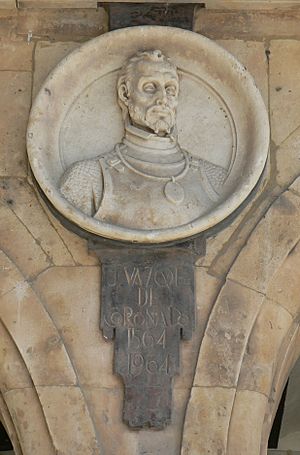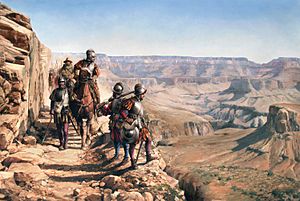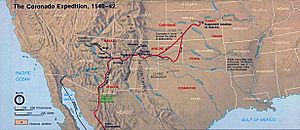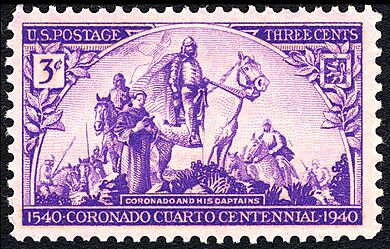Francisco Vázquez de Coronado facts for kids
Quick facts for kids
Francisco Vázquez de Coronado
|
|
|---|---|

Francisco Vázquez Coronado in the Plaza Mayor de Salamanca
|
|
| Governor of New Galicia | |
| Monarch | Charles I |
| Personal details | |
| Born | 1510 Salamanca, Crown of Castile |
| Died | 22 September 1554 (aged 43–44) Mexico City, Viceroyalty of New Spain |
| Military service | |
| Allegiance | |
| Years of service | 1535–1554 |
| Battles/wars | Spanish conquest of Mexico Exploration of North America |
Francisco Vázquez de Coronado y Luján (around 1510 – September 22, 1554) was a Spanish explorer and soldier. He is famous for leading a large expedition through what is now the southwestern United States between 1540 and 1542. He was looking for the legendary Seven Cities of Gold. Coronado explored parts of New Mexico, Arizona, Texas, Oklahoma, and Kansas. He died in 1554.
Contents
Early Life and Journey to New Spain
Francisco Vázquez de Coronado was born into a noble family in Salamanca, Spain, in 1510. He was the second son of Juan Vázquez de Coronado and Isabel de Luján. In 1535, when he was about 25, Coronado traveled to New Spain (which is now Mexico). He went with Antonio de Mendoza, who was the first leader, or Viceroy, of New Spain. Mendoza was a friend of Coronado's family.
In New Spain, Coronado married Beatriz de Estrada. She was only twelve years old at the time. Beatriz was known as "the Saint" (la Santa). Her father was a wealthy colonial treasurer and governor. This marriage helped Coronado become a rich and important person in New Spain.
The Search for Golden Cities
Coronado became the governor of Nueva Galicia, a region in Mexico. He heard stories about a very rich, golden city called Cíbola to the north. These stories came from a friar named Marcos de Niza and an explorer named Estevanico. Marcos de Niza claimed he saw Cíbola from a distance and that it was made of gold.
Coronado and Viceroy Mendoza put a lot of their own money into an expedition to find these golden cities. Mendoza chose Coronado to lead this big journey. In 1540, Coronado set out with a huge group. There were 335 Spanish soldiers, 1,300 Mexican Indian allies, four Franciscan monks, and several slaves.
The expedition traveled north along the Sonoran coast. They kept the Sea of Cortez to their left. Before going into the unknown lands, Coronado divided his group. This was because the land could not support such a large group all at once. Small groups left at different times, and camps were set up to keep the supply route open.
Coronado led the first group of soldiers. They traveled quickly through Sonora, crossing rivers and mountains. They followed the Zuni River into Cíbola, in what is now western New Mexico. But when they arrived, Coronado was very disappointed. Cíbola was not a golden city at all. It was just a group of simple villages belonging to the Zuni people.
Conquering Cíbola and Further Exploration

When Coronado's group reached the Zuni villages, they were very hungry. They asked to enter the village of Hawikuh and trade for food, but they were refused. Coronado's men had to fight to get into Hawikuh and take the food they needed. Coronado himself was injured in this fight. After this, the other Zuni villages did not resist the Spanish. This was considered the "conquest of Cíbola."
While Coronado was recovering, he sent out smaller groups to explore. One group, led by Pedro de Tovar, went to the Hopi villages. They hoped to find more wealth there. The Hopi also resisted at first, but then allowed the Spanish to enter. The Hopi region was not rich either, but the Spanish learned about a large river to the west, the Colorado River.
Another group, led by García López de Cárdenas, went to find this river. They became the first Europeans to see the amazing Grand Canyon! They tried to climb down to the river but couldn't. They reported that the river could not be used to connect with their ships. After this, the main part of Coronado's expedition moved on to other villages along the Rio Grande River in New Mexico.
Exploring the Colorado River
While Coronado was exploring, another part of his expedition tried to connect with ships carrying supplies. Melchor Díaz was a commander who tried to meet up with Hernando de Alarcón's fleet. Díaz traveled overland until he reached where the Colorado River and Gila River meet. Local natives told him that Alarcón's sailors had buried supplies and left a note. The note said that the ships had gone as far upriver as they could, but had to turn back because their ships were getting damaged. Díaz died on his way back to the main group.
Conflicts and the Search for Quivira
Coronado set up his winter camp in a village called Tiguex, near what is now Bernalillo, New Mexico. During the winter of 1540-41, his army's demands for food and supplies caused problems with the local Rio Grande Indians. This led to a harsh conflict called the Tiguex War. Many Indian villages were destroyed, and hundreds of people died.
An Indian guide, whom Coronado called the Turk, told him about a rich land called Quivira to the northeast. Coronado took the Turk as his guide and traveled across a large flat area called the Llano Estacado and into what is now Texas Panhandle. However, Coronado believed the Turk was lying about the route, and the Turk was executed.
Other guides led Coronado further to Quivira, reaching a village near present-day Lindsborg, Kansas. But again, Coronado was disappointed. The Quivira Indians (who were later known as the Wichita) were not rich. Their village had mostly simple huts, and there was no gold to be found. Coronado returned to Tiguex, where his main army had stayed. He spent another winter there.
Return to Mexico
In 1542, Coronado was ordered to return to central New Spain. His troops were needed to help stop a rebellion called the Mixtón Rebellion. He left two Franciscan missionaries behind, as they wanted to stay. Coronado led his forces back to Mexico, mostly along the same route he had taken. By the time he arrived, the rebellion was already over. Only about 100 of his original men returned with him.
Even though his expedition did not find gold and was considered a failure, Coronado remained governor of New Galicia until 1544. However, the expedition had used up all his money, leaving him very poor. In 1544, he retired to Mexico City, where he died in 1554.
Coronado's Family Life
Within a year of arriving in New Spain, Francisco married Beatriz de Estrada. This marriage was important for his career. Beatriz was the second daughter of Alonso de Estrada, a very important person in New Spain. Through this marriage, Coronado became a wealthy man. Beatriz brought with her a large land grant called an encomienda, which was a major source of money for Coronado's expedition.
Beatriz and Francisco had at least four sons and five daughters. After Coronado's death, Beatriz made sure that three of their daughters married into important families in New Spain. She never remarried.
While some reports claimed that Coronado and his family ended their days in poverty, this has been shown to be untrue. Francisco, Beatriz, and their children actually lived comfortably in their later years.
Remembering Coronado
Many places and things are named after Francisco Vázquez de Coronado:
- In 1939, the U.S. Congress allowed a monument to be built near the border where Coronado's expedition first entered North America.
- In 1952, the Coronado National Memorial was created in Sierra Vista, Arizona, to remember his journey.
- The nearby Coronado National Forest is also named in his honor.
- Coronado Butte, a mountain peak in the Grand Canyon, was officially named for him in 1908.
- A large hill in Kansas is called Coronado Heights.
- Several high schools in Texas, Colorado, and Arizona are named Coronado High School.
- Coronado Road in Phoenix, Arizona, and a part of Interstate 40 through Albuquerque are also named after him.
- The mineral Coronadite is named after him.
It's important to note that Coronado, California is not named after Francisco Vázquez de Coronado. It is named after the Coronado Islands, which were named by another explorer in 1602.
Images for kids
-
Coronado Sets Out to the North (Frederic Remington, c. 1900)
-
Vázquez de Coronado as shown at the Deaf Smith County Historical Museum in Hereford, Texas
See also
 In Spanish: Francisco Vázquez de Coronado para niños
In Spanish: Francisco Vázquez de Coronado para niños






